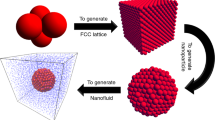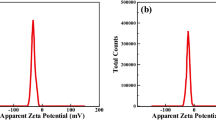Abstract
The thermal behavior of CuO-water nanofluid is examined on an aluminum surface. The dimensions of simulation boxes are 70 × 70 × 30 Å3, 60 × 60 × 30 Å3, and 50 × 50 × 30 Å3, with the corresponding number of atoms of 104,351, 123,958, and 145,980. Thermal conductivities of fluid and nanofluid are calculated using the Green–Kubo formula. Molecular dynamics simulation results confirm the direct effect of nanoparticles on the values of thermal conductivities of fluid and nanofluid. The value of 0.59 Wm−1 K−1 is obtained for the thermal conductivity of water. But adding three CuO nanoparticles into the water increases this value to 0.85 Wm−1 K−1. The same effect is observed on the thermal behavior of nanofluid upon increasing the size of CuO nanoparticles that raises the value of the thermal conductivity of nanofluid to 0.99 Wm−1 K−1. The heat flux is increased by adding the nanoparticles into the base fluid; thereby, the phase transition (evaporation) occurs in fewer time steps.


















Similar content being viewed by others
References
Ahangar SB, et al. The effect of adsorbed volatile organic compounds on an ultrathin water film measurement. Appl Sci. 2020;10(17):5981.
Ahangar SB, et al. Optical properties and swelling of thin film perfluorinated sulfonic-acid ionomer. ECS Trans. 2019;92(8):197.
Ahangar SB, et al. Development of automated angle-scanning, high-speed surface plasmon resonance imaging and SPRi visualization for the study of dropwise condensation. Exp Fluids. 2020;61(1):12.
Karimi-Maleh H, et al. A new nickel-based co-crystal complex electrocatalyst amplified by NiO dope Pt nanostructure hybrid; a highly sensitive approach for determination of cysteamine in the presence of serotonin. Sci Rep. 2020;10:11699.
Karimi-Maleh H, et al. Tuning of metal oxides photocatalytic performance using Ag nanoparticles integration. J Mol Liq. 2020;314:113588.
Karimi-Maleh H, et al. An amplified voltammetric sensor based on platinum nanoparticle/polyoxometalate/two-dimensional hexagonal boron nitride nanosheets composite and ionic liquid for determination of N-hydroxysuccinimide in water samples. J Mol Liq. 2020;310:113185.
Khodadadi H, Toghraie D, Karimipour A. Effects of nanoparticles to present a statistical model for the viscosity of MgO-Water nanofluid. Powder Technol. 2019;342:166–80.
He W, Toghraie D, Lotfipour A, Pourfattah F, Karimipour A, Afrand M. Effect of twisted-tape inserts and nanofluid on flow field and heat transfer characteristics in a tube. Int Commun Heat Mass Transf. 2020;110:104440.
Varzaneh AA, Toghraie D, Karimipour A. Comprehensive simulation of nanofluid flow and heat transfer in straight ribbed microtube using single-phase and two-phase models for choosing the best conditions. J Therm Anal Calorim. 2020;139(1):701–20.
F Soltani, D Toghraie, A Karimipour, Experimental measurements of thermal conductivity of engine oil-based hybrid and mono nanofluids with tungsten oxide (WO3) and MWCNTs inclusions. Powder Technol, 2020
Alipour P, Toghraie D, Karimipour A, Hajian M. Modeling different structures in perturbed Poiseuille flow in a nanochannel by using of molecular dynamics simulation: study the equilibrium. Phys A. 2019;515:13–30.
Alipour P, Toghraie D, Karimipour A, Hajian M. Molecular dynamics simulation of fluid flow passing through a nanochannel: effects of geometric shape of roughnesses. J Mol Liq. 2019;275:192–203.
Yan SR, Shirani N, Zarringhalam M, Toghraie D, Nguyen Q, Karimipour A. Prediction the boiling flow characteristics in rough and smooth microchannels using of molecular dynamics simulation: investigation the effects of boundary wall temperatures. J Mol Liq. 2020;112937:2020.
Alipour P, Toghraie D, Karimipour A. nvestigation the atomic arrangement and stability of the fluid inside a rough nanochannel in both presence and absence of different roughness by using of accurate nano scale. Phys A. 2019;524:639–60.
M Farzinpour, D Toghraie, B Mehmandoust, F Aghadavoudi, A Karimipour, Molecular dynamics study of barrier effects on Ferro-nanofluid flow in the presence of constant and time-dependent external magnetic fields. J Mol Liq 13152, 2020
M Farzinpour, D Toghraie, B Mehmandoust, F Aghadavoudi, A Karimipour, Molecular dynamics simulation of ferronanofluid behavior in a nanochannel in the presence of constant and time-dependent magnetic fields. J Therm Anal Calorim 1–9, 2020
Schlick T. Pursuing laplace’s vision on modern computers. Math Appl Biomol Struct Dyn IMA Vol Math Appl. 1996;82:218–47.
Buongiorno J. Convective transport in nanofluids. J Heat Transf. 2006;128(3):240–50.
Minkowycz W, et al. Nanoparticle heat transfer and fluid flow. CRC Press: Taylor & Francis; 2013.
Das, Sarit K et al., Nanofluids: Science and Technology, 397, 2007
Mecke M, et al. Molecular dynamics simulation of the liquid–vapor interface: the Lennard–Jones fluid. J Chem Phys. 1997;107(21):9264.
Eslami H, et al. Molecular dynamics simulation of liquid–vapor phase equilibria in polar fluids. Chem Phys Lett. 2009;473:66–71.
Sakamaki R, et al. Molecular dynamics simulations of vapor/liquid coexistence using the nonpolarizable water models. J Chem Phys. 2011;134(12):2011.
Horsch M., et al., Steady-state molecular dynamics simulation of vapor to liquid nucleation with McDonald's daemon, arXiv: 0911.5485.
Yamamoto R, Nakanishi K. Computer simulation of vapor-liquid phase separation. Mol Simul. 1996;16:119–26.
Sekine M, et al. Liquid-vapor nucleation simulation of Lennard-Jones fluid by molecular dynamics method. Fluid Dyn Res. 2008;40:597–605.
Mikic BB. On bubble growth rates. Int J Heat Mass Transf. 1970;13:657–66.
Carey P. Liquid-vapor phase-change phenomena: an introduction to the thermophysics of vaporization and condensation processes in heat transfer equipment. Bristol, PA: Taylor & Francis; 1992.
Tehver J, et al. Heat transfer and hysteresis phenomena in boiling on porous plasma-sprayed surface. Exp Therm Fluid Sci. 1992;5:714–27.
Chang JY, You SM. Boiling heat transfer phenomena from microporous and porous surfaces in saturated FC-72. Int J Heat Mass Transf. 1997;40:4427–47.
Rainey KN, You SM. Effects of heater size and orientation on pool boiling heat transfer from microporous coated surfaces. Int J Heat Mass Transf. 2001;44:2589–99.
Mudawar I. Assessment of high-heat-flux thermal management schemes. IEEE Trans Compon Packag Technol. 2001;24:122–41.
Honda H, Wei J. Enhanced boiling heat transfer from electronic components by use of surface microstructures. Exp Therm Fluid Sci. 2014;28:159–69.
Frank M., et al., Thermal conductivity of nanofluid in nanochannels" Microfluid Nanofluid, 19; 2015: 1011–1017.
Ilčin M, et al. Water liquid-vapor equilibrium by molecular dynamics: Alternative equilibrium pressure estimation. Acta Chimica Slovaca. 2016;9(1):36–43.
Alder, B.J. and Wainwright, T.E., Studies in molecular dynamics. I. General method. J Chem Phys 31(2); 1959: 459.
LenMayo SL, et al. DREIDING: a generic force field for molecular simulations. J Phys Chem. 1990;94(26):8897–909.
Mayo SL, et al. DREIDING: a generic force field for molecular simulations. J Phys Chem. 1990;94(26):8897–909.
Murray S, Baskes M. Embedded-atom method: derivation and application to impurities, surfaces, and other defects in metals. Phys Rev B Am Phys Soc. 1984;29(12):6443–53.
Duane R, Roller DHD, The development of the concept of electric charge: electricity from the Greeks to Coulomb. Cambridge, MA: Harvard University Press. 79, 1954.
Sirk TWS, et al. Characteristics of thermal conductivity in classical water models. J Chem Phys. 2013;138(064505):123–37.
Kang J, Wang LW. First-principles Green–Kubo method for thermal conductivity calculations. Phys Rev B. 2018;96(2):2018.
Juris M, et al. Atomic weights of the elements 2013 (IUPAC Technical Report). Pure Appl Chem. 2016;88(3):265–91.
Gleick PH, Water in Crisis: A Guide to the World's Freshwater Resources. Oxford University Press. 13, 1993
Powell T, et al, Ho and Klemens, Purdue Research Foundation, TPRC Data Series 3, 1970
Saterlie M, et al. Particle size effects in the thermal conductivity enhancement of copper-based nanofluids. Nanoscale Res Lett. 2011;6(1):217.
Dehkordi BAF, Abdollahi A. Experimental investigation toward obtaining the effect of interfacial solid-liquid interaction and basefluid type on the thermal conductivity of CuO-loaded nanofluids. Int Commun Heat Mass Transf. 2018;97:151–62.
Orooji Y, et al. Effects of ZrB2 reinforcement on microstructure and mechanical properties of a spark plasma sintered mullite-CNT composite. Ceram Int. 2019;45:16015–21.
Peng Y, Zahedidastjerdi A, Abdollahi A, et al. Investigation of energy performance in a U-shaped evacuated solar tube collector using oxide added nanoparticles through the emitter, absorber and transmittal environments via discrete ordinates radiation method. J Therm Anal Calorim. 2020;139:2623–31.
Orooji Y, et al. Preparation of mullite-TiB2-CNTs hybrid composite through spark plasma sintering. Ceram Int. 2019;45:16288–96.
Razmjou A, et al. Lithium ion-selective membrane with 2D subnanometer channels. Water Res. 2019;159:313–23.
Author information
Authors and Affiliations
Corresponding authors
Additional information
Publisher's Note
Springer Nature remains neutral with regard to jurisdictional claims in published maps and institutional affiliations.
Rights and permissions
About this article
Cite this article
Ghasemi, M., Niknejadi, M. & Toghraie, D. Direct effect of nanoparticles on the thermal conductivity of CuO-water nanofluid in a phase transition phenomenon using molecular dynamics simulation. J Therm Anal Calorim 144, 2483–2495 (2021). https://doi.org/10.1007/s10973-020-10453-z
Received:
Accepted:
Published:
Issue Date:
DOI: https://doi.org/10.1007/s10973-020-10453-z




